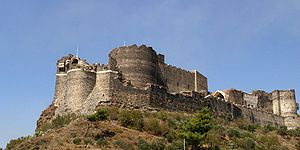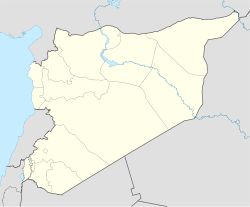- Margat
-
Margat
قلعة المرقبNear Baniyas, Syria 
Type Concentric castle Coordinates 35°09′04″N 35°56′57″E / 35.151111°N 35.949167°ECoordinates: 35°09′04″N 35°56′57″E / 35.151111°N 35.949167°E Built 1062 Construction
materialsBasalt Current
conditionRuin, under renovation Open to
the publicYes Margat, also known as Marqab from the Arabic Qalaat al-Marqab (قلعة المرقب, "Castle of the Watchtower") is a castle near Baniyas, Syria, which was a Crusader fortress and one of the major strongholds of the Knights Hospitaller. It is located around 2 km from the Mediterranean coast, approximately 6 km south of Baniyas.
The castle had been in poor preservation until 2007, when some reconstruction and renovation started.Contents
History
Margat is located on a hill about 360 metres above sea level, formed by an extinct volcano on the road between Tripoli and Latakia, overlooking the Mediterranean Sea.
According to Arab sources, the site of Margat Castle was first fortified in 1062 by Muslims.[1] They continued to hold it within the Christian Principality of Antioch in the aftermath of the First Crusade. When the Principality was defeated at the Battle of Harran in 1104, the Byzantine Empire took advantage of their weakness and captured Margat from the Muslims. A few years later it was captured by Tancred, Prince of Galilee, regent of Antioch, and was incorporated into the Principality.
In the 1170s it was controlled by Reynald II Mazoir of Antioch as a vassal of the count of Tripoli; the fortress was so large that it had its own household officials and a number of rear-vassals. His son Bertrand sold it to the Hospitallers in 1186 as it was too expensive for the Mazoir family to maintain. After some rebuilding and expansion by the Hospitallers, it became their headquarters in Syria. Under Hospitaller control, its fourteen towers were thought to be impregnable.
In 1188, Saladin marched on Margat having left Krak des Chevaliers in search of easier prey. According to Abu'l-Fida, "Recognising that Maqab was impregnable and that he had no hope of capturing it, he passed on to Jabala".[2] It was one of the few remaining territories left in Christian hands after Saladin's conquests.
By the beginning of the 13th century the Hospitallers controlled the surrounding land and roads and made a large profit from travellers and pilgrims passing through. Isaac Comnenus of Cyprus was imprisoned there after Richard I of England captured Cyprus from him during the Third Crusade. The bishop of nearby Valenia also used Margat as his headquarters after around 1240. Margat was second in size in power only to the other Hospitaller fortress to the south, Krak des Chevaliers.
The Mamluk sultan of Egypt Qalawun besieged it beginning on April 25, 1285, and captured it after a month when sappers mined the north wall. Qalawun respected the size of the fortress and the courage of its defenders, and allowed the Hospitallers to leave with everything they could carry. Rather than destroy it as he did with other fortresses, he placed a Mamluk garrison in it.
Architecture
Castles in Europe provided lordly accommodation for their owners and acted a centres of administration; in the Levant the need for defence was paramount and this was reflected in castle design. Historian Hugh Kennedy suggests that "The castle scientifically designed as a fighting machine surely reached its apogee in great buildings like Margat and Crac des Chevaliers."[3] Like the Krak des Chevaliers, Margat is a large spur castle with many typical elements of a concentric castle. It has a bent entrance leading through the base of a gate tower. A notable feature of the inner defences is a large circular tower, sometime referred to as a donjon (though it should not be confused with a central keep). Unlike Krak, Margat has a large outer ward, giving it a larger total area.
See also
References
- Notes
- ^ Kennedy 1994, p. 20
- ^ Kennedy 1994, p. 164
- ^ Kennedy 1994, p. 9
- Bibliography
- Kennedy, Hugh (1994), Crusader Castles, Cambridge: Cambridge University Press, ISBN 0-521-42068-7
Further reading
- Folda, Jaroslav; French, Pamela; Coupel, Pierre (1982), "Crusader Frescoes at Crac des Chevaliers and Marqab Castle", Dumbarton Oaks Papers (Dumbarton Oaks, Trustees for Harvard University) 36: 177–210, JSTOR 1291467
- Rey, Guillaume (1871) (in French), Etudes sur les monuments de l'architecture militaire des Croisés en Syrie et dans l'ile de Chypre, Paris: Impr. nationale, http://www.archive.org/details/tudesurlesmonum01reygoog
External links
Categories:- Crusader castles
- Castles in Syria
- Knights Hospitaller
- Mameluk castles
- Tartus Governorate
Wikimedia Foundation. 2010.

